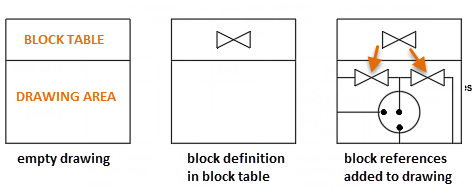A block can be composed of objects drawn on several layers with various properties. You can use several methods to create blocks.
How Blocks are Stored and Referenced
A block can be composed of objects drawn on several layers with various colors, linetypes, and lineweight properties. Whenever you create a block or insert a drawing as a block, all block information (including geometry, layers, colors, and linetypes) is stored in a behind-the-scenes table of definitions. Every block you insert is actually a reference to a block definition. Although a block is always inserted on the current layer, the block reference preserves information about the original layer, color, and linetype properties of the objects that are contained in the block. You can control whether objects in a block retain their original properties or inherit their properties from the current layer, color, linetype, or lineweight settings.
- The block definition table
- The objects in the drawing

When you insert a block you are inserting a block reference. The information is not copied from the block definition to the drawing area. Instead, a link is established between the block reference and the block definition. Therefore, if the block definition is changed, all references are updated automatically.
- If you redefine a block definition, all references in that drawing are updated automatically.
- You help control the drawing size by inserting references instead of object geometry.
You remove a block reference by erasing it. However, the corresponding block definition remains. To reduce the size of a drawing, you must also remove any unused block definitions by purging them.
Annotative Blocks
You can also create annotative blocks. For more information about creating and working with an annotative blocks, see Create Annotative Blocks and Attributes.